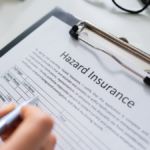Loss of Use insurance, also known as Additional Living Expenses (ALE) coverage, ensures that if you are forced to leave your home due to damage from a covered event — like a fire, a windstorm, or vandalism — your property insurance policy can cover the difference between your usual living expenses and the increased costs you have to take on having to live somewhere else.
In other words, it gives you a little financial breathing room when the unexpected happens.
When displacement becomes a reality
Picture this: your home becomes uninhabitable after a major covered event. Your family is suddenly faced with the challenge of finding temporary housing, covering expenses you hadn’t anticipated — like eating out more, dealing with a longer commute, and maintaining some sense of normalcy.
But major events aren’t the only reasons you might be forced to leave your home: displacement can occur for many reasons. A broken water pipe can flood your basement or kitchen, forcing you to vacate while repairs are made. Freak weather systems can bring trees crashing through roofs, rendering entire sections of your home unsafe to live in.
Other, less obvious events can also cause displacement. Recent news events — like toxic spills from industrial accidents or train derailments — have devastated entire neighborhoods, leaving many homeowners scrambling for temporary housing.
Leaving may not even be a personal choice: authorities may mandate evacuations until the area is deemed safe again. So, while your home may not suffer direct damage, it can still be weeks before you can return.
Enter Loss of Use insurance
The scenarios outlined above are unexpected and can happen to anyone, anywhere. That’s why having Loss of Use insurance is important. It steps in to bridge the gap between your regular living expenses and the increased costs of temporary housing and other essentials.
You probably already have it — it’s is a common feature in most homeowners insurance, condo insurance and renters insurance policies, often referred to as Coverage D. Here’s a closer look at what Loss of Use insurance typically covers:
- Temporary Housing Costs: Whether you need to stay in a hotel, rent an apartment, or find another temporary living arrangement, Loss of Use insurance helps pay the cost difference from your normal housing expenses.
- Meal Expenses: If your temporary home lacks kitchen facilities, your insurance can cover the extra cost of eating out (or getting meals delivered) compared to what you’d typically spend on groceries.
- Transportation Costs: Displacement might mean longer commutes or relying on different (and more expensive) transportation needs. Loss of Use coverage can be used to reimburse some or all of the additional expenses related to travel during your displacement.
- Temporary Storage or Moving Costs: If extensive repairs require you to move out and store your belongings, Loss of Use coverage can help with those costs as well.
- Pet Care: If you have to find temporary boarding for pets due to housing restrictions, those expenses may also be covered by Loss of Use insurance.
Why Loss of Use coverage matters
Without Loss of Use insurance, even a relatively short displacement can drain your savings. According to a 2024 study by J.D. Power, the average daily rate (ADR) for a U.S. hotel room in 2024 was $158. Consider multiplying that ADR a week or more, plus eating out for every meal, renting a new car, and having to spend more on gas because of a longer commute.
Add in the possibility of long-term repairs or rebuilding, and the bills can quickly climb into the thousands. Loss of Use insurance allows you to maintain your standard of living and continue taking care of your family during such a difficult time — without having to dip much into your savings or take on debt.
In larger-scale disasters like hurricanes or wildfires, where entire communities are affected, the demand for temporary housing and services can skyrocket. This can drive up costs even further, making Loss of Use coverage even more necessary.
Making a Loss of Use claim
Filing a claim for Loss of Use insurance might be a bit more complicated than other types of claims, but there are ways to make the process easier.
- The first step is to notify your insurance company as soon as possible after being forced out of your home. Your insurer will assign a claims adjuster who will evaluate your situation and determine what costs are eligible for reimbursement.
- Be sure to keep detailed records of all your expenses while you’re displaced. Save receipts for meals, hotel stays, transportation, laundry services, and any other unexpected or additional costs. Insurance companies often need you to prove that these extra expenses are above your usual spending. For example, according to USA Today, the average family spends about $270 on groceries each week. If that sounds like your family, and youre now spending $370 because you’re eating out for every meal, loss of insurance would only cover the $100 difference.
- Stay in regular contact with your insurer to make sure your temporary housing and other arrangements fit their coverage guidelines. Sometimes, insurers work with specific hotels or have caps on daily food expenses, which can make things easier. Knowing your policy limits ahead of time can help you avoid unexpected costs, and keeping your expenses well-organized and documented will make the claims process go more smoothly.
Review Loss Of Use coverage in your homeowners or renters policy
When you review your homeowners or renters insurance, make sure your Loss of Use coverage fits your specific needs. Every household is unique, and how much coverage you need can vary based on the size of your family, your lifestyle, and the cost of living in your area. Here are some things to think about:
- Start by evaluating your current living expenses — things like rent or mortgage payments, utilities, and typical grocery and transportation costs.
- Next, consider how these expenses might increase if you were forced to relocate temporarily. Would you need to rent an apartment, stay in a hotel, or find alternative housing? How far away from work or school would that be? Would your younger kids need to get into a new daycare system? What would it cost to replicate your day-to-day elsewhere?
- Now consider how long you could potentially be displaced, as home repairs and renovations can take months — especially in the case of major damage or disruption.
If you live in a high-risk area for natural disasters like hurricanes, earthquakes, or wildfires, it might make sense to increase your Loss of Use coverage. You may also want to consider any special circumstances — such as pets, medical needs, or home-based businesses — that could screw with your finances if you were forced to leave your home for an extended period of time.
Talk to your insurance agent about these factors to make sure your policy is tailored to your needs and gives you enough protection in an emergency.
Learn more about Loss of Use and Additional Living Expenses coverage
While Loss of Use insurance might seem like a small part of your policy, it’s important for keep your bank account from being drained during a major crisis.
If you still have questions or need a quote on your property insurance — including Loss of Use or Additional Living Expenses coverage — speak with a Guided Solutions expert. We’ll help you explore your options and make smart choices to protect your home and finances when the unexpected happens. And we’ll take care of all the details to find the right policy for your needs.
Ready to get started? Call us at (833) 791-4719, or reach out today online at the following links:







